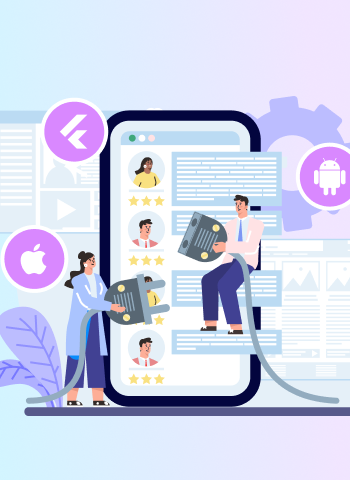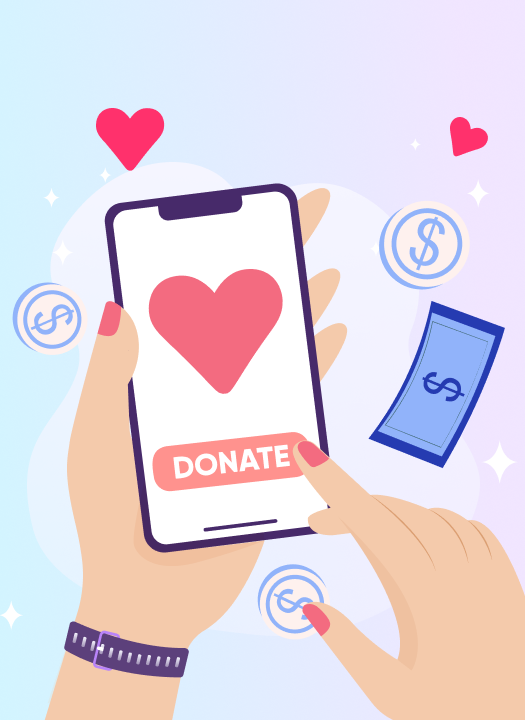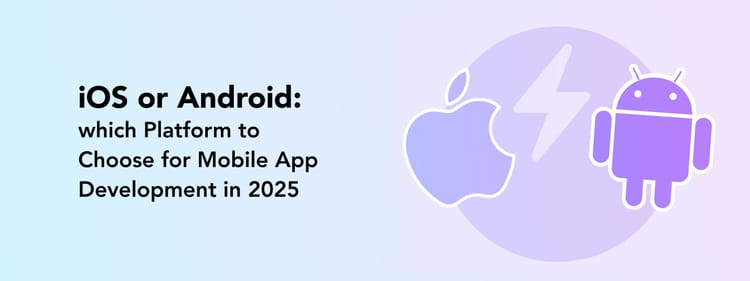Most prospective startup owners come to software development companies with just an idea. That’s a common situation for us in Perpetio too: many of our clients have only a set of requirements, research results, or simply a concept of an app they want to get developed.
It’s the task of the development partner to work on all the steps of the process that transforms a list of ideas into a full-fledged, working application. This process is called full cycle software development.
Let’s explore what are the main software development steps for businesses and what their approximate budget should be in this full cycle software development guide.
What is Full Cycle Software Development?

Full cycle software development concept is an approach to creating digital products when one team takes care of the process from the concept ideation to launch and maintenance. In other words, a client collaborates with only one technological partner for each stage of product development. A single company is
- working on the project’s requirements and concept
- planning the work scope, conducting research, deciding on the feature set
- designing the product’s UX and UI
- developing the product and making technological decisions
- testing the product
- preparing the product for launch, receiving necessary certifications, taking care of marketing activities
- maintaining the product and making needed updates; scaling up if requested
According to Elliott & Strachan & Radford, the concept of full cycle software development was first introduced in the 1960s (wow!) mostly for enterprise-level business infrastructures. Since then, it remains one of the most popular methodologies of software development and is widely used for projects of all scales, including startups and MVPs.
Full Cycle Software Development: From Zero to MVP

Talking about MVPs (minimum viable product), let’s take a look behind the curtains at how a digital product, more precisely a mobile app, is created step by step. We will describe an example of an MVP for a startup but these steps apply to mid-scale projects too.
Planning and analysis
The first one among full cycle software development stages is to plan the project. This includes
- setting goals
- researching the target audience
- defining objectives and requirements
- creating a timeline for the project
- budgeting resources
- choosing a development methodology
At Perpetio, as a client, you have the last word in making all of these decisions while, at the same time, we will provide consulting and help make the right choices. Our project managers and business development specialists will offer you the working strategies and suggest a project proposal with all the practical details.
Once these steps have been undertaken, business analysts, product owners, or UI/UX designers conduct research to understand what kind of an app the market would welcome. It includes user surveys and interviews as well as market research into existing similar apps.
Design and prototyping
After all the planning is done, the design work can begin. This will involve creating the app’s UX design which focuses on the app’s content, navigation between the app’s screen, and all the experience a user is getting from the product as well as UI design centered around the visual aesthetics of the app.
Usually, the next step after researching is creating wireframes: rough sketches that illustrate how users will interact with the app’s various screens in order to execute their desired tasks or actions. Wireframes outline the basic structure of each screen and the relations between screens. Additionally, to work on the app’s navigation in more detail, a designer can create a user journey map.
After the client approves the wireframes, a UI/UX designer can start working with the visual aspect of the application’s design, such as typography, color palette, and illustrations.
Development and testing
After the UI/UX design is all done, it’s time to bring it to life by coding both front-end (interface) components and back-end (server-side) programming. Depending on your choice of platform for the app, be it iOS or Android, the development process might differ. Usually, developers will create native applications:
- iOS apps written using the Swift programming language
- Android apps written using the Kotlin programming language
At the same time, if you are looking to introduce your app to two markets simultaneously, going with cross-platform Flutter development can be a good idea. With Flutter, one codebase can run on both iOS and Android platforms and save you time & budget.
After the code is all written, it has to be tested by a quality assurance specialist to detect any bugs and inconsistencies. Usually, testers check the application both manually by acting as a user and with the assistance of automated tools. A QA specialist not only searches for technical mistakes but evaluates the app’s performance and functionality all in all. Testing is no less important among full cycle software development phases because it is the only way to ensure the best possible user experience and avoid any disappointments later.
Deployment and maintenance
Finally after the successful completion of all tests it is time for deployment where an app is sent out into the production environment. The team you are working with will make sure that the app complies with all the platform’s technical requirements and might do marketing activities for you.
Post-release maintenance is important too because software can not remain static forever since more changes usually follow based on user feedback over time. Additionally, over time, you might want to extend your MVP with a richer feature set and it’s best to trust the same team with the task.
Possible Restrains of Full Cycle Software Development

If done right, there should be no bumps on your way from the first app concept to the finished product. Still, there might be some challenges of full cycle software development that will drag your project behind. When working with a full cycle software development company, look out for these signs:
Inexperienced team
An experienced and reliable team is responsible for a big part of the product’s success, so choosing a company that doesn’t have enough skills in certain technologies, is weak in understanding the business models, or just is unfamiliar with your domain may result in the product far from your dreams.
Wrong technologies
Each digital project is like a snowflake: special and requires a different set of technologies. Depending on the app’s platform, size, target audience, and even region the choice of a framework will vary. It’s critical to find a tech stack that won’t be too simple or overly complicated for your app as well as avoid any conflict between the tools.
This problem is connected with the issue we described earlier: an inexperienced team. A knowledgeable developer will choose the appropriate tools and frameworks to make the best out of the technical capabilities of your app.
Highly Complex Architecture
Overcomplicating an MVP project is a common mistake many startup owners are drawn to make. The more features the better, isn’t it true? Not for newly-launched mobile apps. An MVP needs to present only the essential, most valuable features.
Additionally, a professional developer will build an app with a simple architecture, so it is easier to manage, deploy, and maintain. A complex architecture is just not needed for MVP projects and can be a way to pour your money down the drain.
Security Gaps
One technological aspect of full cycle software development that deserves a lot of developers’ attention is security. Any mobile application, be it a game or online banking, collects data about the users, from their names and emails to payment details. Any leaking of such information can lead to incredible financial losses and decreased user trust. That’s why security should be on the top priority list for any developer and QA engineer. Make sure to discuss the security protocols with your team.
Unclear Project Scope
One of the biggest challenges with full cycle software development can occur right in the beginning. A task of a project manager is to define clear requirements, deadlines, and outcomes for each stage of the app development. Even before the work on your project starts, you will meet with the sales representative and project manager to discuss your needs and expectations.
If you are not clear about what the final result should be or if the company representative doesn’t calculate the work scope and risks correctly, there is a chance the deadlines will be put off and the result won’t be as you expected. It’s best if you are honest with the team and stick to your original request: changing the project scope in the process will seriously disrupt the work.
Top Technologies Perpetio Uses for Full Cycle Software Development

Now that you know which mistakes to avoid when getting a full cycle development service, let’s discuss the full cycle software development features, more precisely, the top technologies to use for your project.
Tech Stacks
A tech stack refers to all the tools used to build your application. We will talk about frameworks and other technologies in detail in a bit; for now, let’s focus on programming languages.
Native languages such as Kotlin and Swift are designed to work on specific operating systems, which are Android and iOS. This ensures that the app will run smoothly on the appropriate device. Additionally, native languages provide access to all of the hardware features available on devices, allowing developers to create more powerful applications with improved performance capabilities.
Cross-platform frameworks offer an alternative solution for developing apps across multiple platforms simultaneously. Flutter is rapidly gaining popularity as a popular choice due to its high levels of flexibility and speed of development. It uses the Dart programming language which provides access to powerful features such as rich UI elements, animation libraries, and integration with Firebase for quick prototyping without sacrificing performance or scalability when running the app on different devices.
However, some features may not be available in cross-platform solutions like those found in native applications; for example, gestures recognition or exclusive APIs from companies like Apple or Google that are sometimes required in apps, like iBeacon API for geofencing on iOS devices.
Frameworks and APIs
While programming languages are the basis of any app’s code, developers layer frameworks and APIs to add extra functionality to their products. Frameworks are used to simplify the work on the app or make the process more productive.
Some frameworks, like Flutter or React Native, are cross-platform solutions for building one codebase that runs on iOS and Android alike. Others, for example, SnapKit or Dagger, assist developers with managing the code more effectively.
APIs provide specific instructions on how two pieces of software interact with each other enabling them to communicate regardless of different coding languages or operating systems. Mobile application programming interfaces include Google Maps API, Facebook Login API, Twitter API, Flickr API, and others.
Databases
Databases have become indispensable for modern mobile apps as they provide secure storage for all kinds of data such as user accounts, settings, images, videos, and so on. Most databases for mobile apps these days are cloud, so developers and users can access and modify the information at any point.
Database service providers like Firebase, Google Cloud Databases, and Amazon Web Services take their security seriously. Data stored in cloud databases is safe as it is encrypted making it virtually impossible for hackers to gain access unless they possess passwords or authorization keys.
Protocols
Protocols typically involve communication between different software components, as well as between devices and applications. Your app won’t exist in a vacuum and will definitely interact with other devices or systems. Users might want to use in-app contactless payment or screen the app to their TV. Some of the most necessary protocols for mobile app development include Bluetooth, Wi-Fi, Near Field Communication (NFC), and Universal Plug and Play (UPnP).
If you probably know a lot about Bluetooth and Wi-Fi, the two latter protocols might be unknown. NFC is a short-range radio frequency technology used primarily for secure contactless payments and device pairing, such as Android Beam. It’s also commonly used when integrating contactless payment, such as Apple Pay and Google Wallet.
Universal Plug and Play (UPnP) is an open network standard designed to enable easy discovery of compatible networked devices on local area networks (LANs). It allows you to quickly identify which services your application supports so users don’t have any trouble finding them on their device’s home screen or menus. Additionally, many popular streaming media players use UPnP for content delivery which makes this protocol essential when developing streaming media apps like Netflix or Hulu Plus.
How Much Does Full Cycle Software Development Cost?
The cost of full cycle software development can vary significantly depending on the size and scope of the project. Generally speaking, full cycle app development costs range from $20 000 to $100 000 for an MVP project. The exact cost will depend on a variety of factors such as the complexity of the project, technology used, team size, and experience level among others.
For example, collaborating with an experienced outsourcing team from Ukraine will give you a high-quality product with top technologies used for a reasonable price.
Consider Perpetio Your Trusted Partner

Perpetio is one of the teams you can choose for full cycle development. We specialize in mobile app development and have extensive experience building mobile products from fitness app development with Flutter to native delivery service solutions. Additionally, we offer free business and tech consulting along the way, so you can let your hair down and make decisions that are right for you. With a flexible development approach and English-speaking specialists, the collaboration will be comfortable for you and productive for the project.
Not to just brag, let us show you one of our recent projects. Recently, we undertook a task to build an image recognition application. It is a fitness application that does all the counting for the user! A user can complete a certain exercise, like sit-ups, and the app will count them with image recognition technology. Fun and convenient, isn’t it?
We put innovative thinking, creativity, and technological expertise into each of our projects. And yours can be the next one!
FAQ
Does Perpetio provide full cycle software development solutions?
Yes, Perpetio takes full cycle mobile app development projects.
How much does it cost to get a custom full cycle software development?
Generally speaking, full cycle app development costs range from $20 000 to $100 000 for an MVP project.
How long is the full cycle of software development?
The timeframe of full cycle software development varies from 4 months to up to one year.
What supports full cycle software development?
Full cycle software development is a process consisting of several stages, usually five: requirements analysis, UI/UX design, development, testing, and release.





